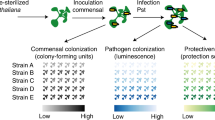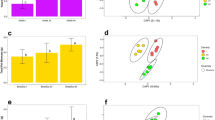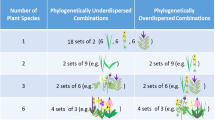Abstract
The plant phyllosphere constitutes a habitat for numerous microorganisms; among them are members of the genus Methylobacterium. Owing to the ubiquitous occurrence of methylobacteria on plant leaves, they represent a suitable target for studying plant colonization patterns. The influence of the factor site, host plant species, time and the presence of other phyllosphere bacteria on Methylobacterium community composition and population size were evaluated in this study. Leaf samples were collected from Arabidopsis thaliana or Medicago truncatula plants and from the surrounding plant species at several sites. The abundance of cultivable Methylobacterium clearly correlated with the abundance of other phyllosphere bacteria, suggesting that methylobacteria constitute a considerable and rather stable fraction of the phyllosphere microbiota under varying environmental conditions. Automated ribosomal intergenic spacer analysis (ARISA) was applied to characterize the Methylobacterium community composition and showed the presence of similar communities on A. thaliana plants at most sites in 2 consecutive years of sampling. A substantial part of the observed variation in the community composition was explained by site and plant species, especially in the case of the plants collected at the Arabidopsis sites (50%). The dominating ARISA peaks that were detected on A. thaliana plants were found on other plant species grown at the same site, whereas some different peaks were detected on A. thaliana plants from other sites. This indicates that site-specific factors had a stronger impact on the Methylobacterium community composition than did plant-specific factors and that the Methylobacterium–plant association is not highly host plant species specific.
Similar content being viewed by others
Log in or create a free account to read this content
Gain free access to this article, as well as selected content from this journal and more on nature.com
or
References
Abanda-Nkpwatt D, Müsch M, Tschiersch J, Boettner M, Schwab W . (2006). Molecular interaction between Methylobacterium extorquens and seedlings: growth promotion, methanol consumption, and localization of the methanol emission site. J Exp Bot 57: 4025–4032.
Adams PD, Kloepper JW . (2002). Effect of host genotype on indigenous bacterial endophytes of cotton (Gossypium hirsutum L.). Plant Soil 240: 181–189.
Bailey JK, Deckert R, Schweitzer JA, Rehill BJ, Lindroth RL, Gehring C et al. (2005). Host plant genetics affect hidden ecological players: links among Populus, condensed tannins, and fungal endophyte infection. Can J Bot 83: 356–361.
Balachandar D, Raja P, Sundaram SP . (2008). Genetic and metabolic diversity of pink-pigmented facultative methylotrophs in phyllosphere of tropical plants. Braz J Microbiol 39: 68–73.
Berg G, Smalla K . (2009). Plant species and soil type cooperatively shape the structure and function of microbial communities in the rhizosphere. FEMS Microbiol Ecol 68: 1–13.
Bonnin I, Huguet T, Gherardi M, Prosperi JM, Olivieri I . (1996). High level of polymorphism and spatial structure in a selfing plant species, Medicago truncatula (Leguminosae), shown using RAPD markers. Am J Bot 83: 843–855.
Borcard D, Legendre P, Drapeau P . (1992). Partialling out the spatial component of ecological variation. Ecology 73: 1045–1055.
Corpe WA, Rheem S . (1989). Ecology of the methylotrophic bacteria on living leaf surfaces. FEMS Microbiol Ecol 62: 243–249.
Delmotte N, Knief C, Chaffron S, Innerebner G, Roschitzki B, Schlapbach R et al. (2009). Community proteogenomics reveals insights into the physiology of phyllosphere bacteria. Proc Natl Acad Sci USA 106: 16428–16433.
Elbeltagy A, Nishioka K, Suzuki H, Sato T, Sato YI, Morisaki H et al. (2000). Isolation and characterization of endophytic bacteria from wild and traditionally cultivated rice varieties. Soil Sci Plant Nutr 46: 617–629.
Galbally IE, Kirstine W . (2002). The production of methanol by flowering plants and the global cycle of methanol. J Atmos Chem 43: 195–229.
Gourion B, Rossignol M, Vorholt JA . (2006). A proteomic study of Methylobacterium extorquens reveals a response regulator essential for epiphytic growth. Proc Natl Acad Sci USA 103: 13186–13191.
Green PN . (2006). Methylobacterium. In: Dworkin M, Falkow S, Rosenberg E, Schleifer K-H, Stackebrandt E (eds). The Prokaryotes. Springer: New York, pp. 257–265.
Hirano SS, Upper CD . (1991). Bacterial community dynamics. In: Andrews JH, Hirano SS (eds). Microbial Ecology on Leaves. Springer-Verlag: New York, pp 271–294.
Holland MA, Long RLG, Polacco JC . (2002). Methylobacterium spp.: Phylloplane bacteria involved in cross-talk with the plant host. In: Lindow SE, Hecht-Poinar EI, Elliott VJ (eds). Phyllosphere Microbiology. APS Press: St Paul, Minnesota, pp 125–135.
King EO, Ward MK, Raney DE . (1954). Two simple media for the demonstration of pyocyanin and fluorescin. J Lab Clin Med 44: 301–307.
Kinkel LL . (1997). Microbial population dynamics on leaves. Annu Rev Phytopathol 35: 327–347.
Knief C, Frances L, Cantet F, Vorholt JA . (2008). Cultivation-independent characterization of Methylobacterium populations in the plant phyllosphere by automated ribosomal intergenic spacer analysis. Appl Environ Microbiol 74: 2218–2228.
Kutschera U . (2007). Plant-associated methylobacteria as co-evolved phytosymbionts. Plant Signal Behav 2: 74–78.
Legendre P, Gallagher ED . (2001). Ecologically meaningful transformations for ordination of species data. Oecologia 129: 271–280.
Legendre P, Legendre L . (1998). Numerical Ecology. Elsevier Science BV: Amsterdam.
Leveau JH . (2006). Microbial communities in the phyllosphere. In: Riederer M, Müller C (eds). Biology of the Plant Cuticle. Blackwell: Oxford, pp 334–367.
Lindow SE, Brandl MT . (2003). Microbiology of the phyllosphere. Appl Environ Microbiol 69: 1875–1883.
Lindow SE, Leveau JH . (2002). Phyllosphere microbiology. Curr Opin Biotechnol 13: 238–243.
Martiny JBH, Bohannan BJM, Brown JH, Colwell RK, Fuhrman JA, Green JL et al. (2006). Microbial biogeography: putting microorganisms on the map. Nat Rev Microbiol 4: 102–112.
Mcinroy JA, Kloepper JW . (1995). Survey of indigenous bacterial endophytes from cotton and sweet corn. Plant Soil 173: 337–342.
Mercier J, Lindow SE . (2000). Role of leaf surface sugars in colonization of plants by bacterial epiphytes. Appl Environ Microbiol 66: 369–374.
Nunn DN, Lidstrom ME . (1986). Isolation and complementation analysis of 10 methanol oxidation mutant classes and identification of the methanol dehydrogenase structural gene of Methylobacterium sp. strain AM1. J Bacteriol 166: 581–590.
Omer ZS, Tombolini R, Gerhardson B . (2004). Plant colonization by pink-pigmented facultative methylotrophic bacteria (PPFMs). FEMS Microbiol Ecol 47: 319–326.
Opelt K, Berg C, Schonmann S, Eberl L, Berg G . (2007). High specificity but contrasting biodiversity of Sphagnum-associated bacterial and plant communities in bog ecosystems independent of the geographical region. ISME J 1: 502–516.
Pico FX, Mendez-Vigo B, Martinez-Zapater JM, Alonso-Blanco C . (2008). Natural genetic variation of Arabidopsis thaliana is geographically structured in the Iberian Peninsula. Genetics 180: 1009–1021.
Pirttilä AM, Laukkanen H, Pospiech H, Myllylä R, Hohtola A . (2000). Detection of intracellular bacteria in the buds of Scotch pine (Pinus sylvestris L.) by in situ hybridization. Appl Environ Microbiol 66: 3073–3077.
Raja P, Balachandar D, Sundaram SP . (2008). Genetic diversity and phylogeny of pink-pigmented facultative methylotrophic bacteria isolated from the phyllosphere of tropical crop plants. Biol Fertil Soils 45: 45–53.
Ramette A . (2007). Multivariate analyses in microbial ecology. FEMS Microbiol Ecol 62: 142–160.
Ramette A, Tiedje JM . (2007). Multiscale responses of microbial life to spatial distance and environmental heterogeneity in a patchy ecosystem. Proc Natl Acad Sci USA 104: 2761–2766.
Rasche F, Marco-Noales E, Velvis H, van Overbeek LS, Lopez MM, van Elsas JD et al. (2006). Structural characteristics and plant-beneficial effects of bacteria colonizing the shoots of field grown conventional and genetically modified T4-lysozyme producing potatoes. Plant Soil 289: 123–140.
Redford AJ, Fierer N . (2009). Bacterial succession on the leaf surface: a novel system for studying successional dynamics. Microb Ecol 58: 189–198.
Reiter B, Wermbter N, Gyamfi S, Schwab H, Sessitsch A . (2003). Endophytic Pseudomonas spp. populations of pathogen-infected potato plants analysed by 16S rDNA- and 16S rRNA-based denaturating gradient gel electrophoresis. Plant Soil 257: 397–405.
Sait L, Galic M, Strugnell RA, Janssen PH . (2003). Secretory antibodies do not affect the composition of the bacterial microbiota in the terminal ileum of 10-week-old mice. Appl Environ Microbiol 69: 2100–2109.
Schweitzer JA, Bailey JK, Bangert RK, Hart SC, Whitham TG . (2006). The role of plant genetics in determining above- and below-ground microbial communities. In: Bailey MJ, Lilley AK, Timms-Wilson TM, Spencer-Phillips PTN (eds). Microbial Ecology of Aerial Plant Surfaces. CABI International: Wallingford, UK, pp. 107–120.
Stapleton AE, Simmons SJ . (2006). Plant control of phyllosphere diversity: genotype interactions with ultraviolet-B radiation. In: Bailey MJ, Lilley A, Timms-Wilson TM, Spencer-Phillips PTN (eds). Microbial Ecology of Aerial Plant Surfaces. CABI International: Wallingford, UK, pp 223–238.
Sy A, Timmers AC, Knief C, Vorholt JA . (2005). Methylotrophic metabolism is advantageous for Methylobacterium extorquens during colonization of Medicago truncatula under competitive conditions. Appl Environ Microbiol 71: 7245–7252.
Timms-Wilson TM, Smalla K, Goodall TI, Houlden A, Gallego V, Bailey MJ . (2006). Microbial diversity in the phyllosphere and rhizosphere of field grown crop plants: microbial specialisation at the plant surface. In: Bailey MJ, Lilley AK, Timms-Wilson TM, Spencer-Phillips PTN (eds). Microbial Ecology of Aerial Plant Surfaces. CABI International: Wallingford, UK, pp 21–36.
van Overbeek L, van Elsas JD . (2008). Effects of plant genotype and growth stage on the structure of bacterial communities associated with potato (Solanum tuberosum L. FEMS Microbiol Ecol 64: 283–296.
Whipps JM, Hand P, Pink D, Bending GD . (2008). Phyllosphere microbiology with special reference to diversity and plant genotype. J Appl Microbiol 105: 1744–1755.
Yadav RK, Karamanoli K, Vokou D . (2005). Bacterial colonization of the phyllosphere of Mediterranean perennial species as influenced by leaf structural and chemical features. Microb Ecol 50: 185–196.
Yang CH, Crowley DE, Borneman J, Keen NT . (2001). Microbial phyllosphere populations are more complex than previously realized. Proc Natl Acad Sci USA 98: 3889–3894.
Acknowledgements
This study was supported by the Centre National de la Recherche Scientifique and ETH Zurich. We acknowledge Jean-Marie Prosperi (UMR 1097, INRA Montpellier, France) who showed us natural populations of M. truncantula. Pascaline Guillemot is acknowledged for her help with the collection of plant material in 2006.
Author information
Authors and Affiliations
Corresponding author
Additional information
Supplementary Information accompanies the paper on The ISME Journal website
Supplementary information
Rights and permissions
About this article
Cite this article
Knief, C., Ramette, A., Frances, L. et al. Site and plant species are important determinants of the Methylobacterium community composition in the plant phyllosphere. ISME J 4, 719–728 (2010). https://doi.org/10.1038/ismej.2010.9
Received:
Revised:
Accepted:
Published:
Issue date:
DOI: https://doi.org/10.1038/ismej.2010.9
Keywords
This article is cited by
-
The Arabidopsis holobiont: a (re)source of insights to understand the amazing world of plant–microbe interactions
Environmental Microbiome (2023)
-
The microbiome of Riccia liverworts is an important reservoir for microbial diversity in temporary agricultural crusts
Environmental Microbiome (2023)
-
Phyllosphere symbiont promotes plant growth through ACC deaminase production
The ISME Journal (2023)
-
Plant-associated bacteria of Syringa vulgaris L. in an urban environment
Plant and Soil (2023)
-
Characteristics of Phyllosphere Microbial Communities Associated with Three Different Plants in the Semi-arid Areas of Northwest Liaoning
Journal of Soil Science and Plant Nutrition (2023)



